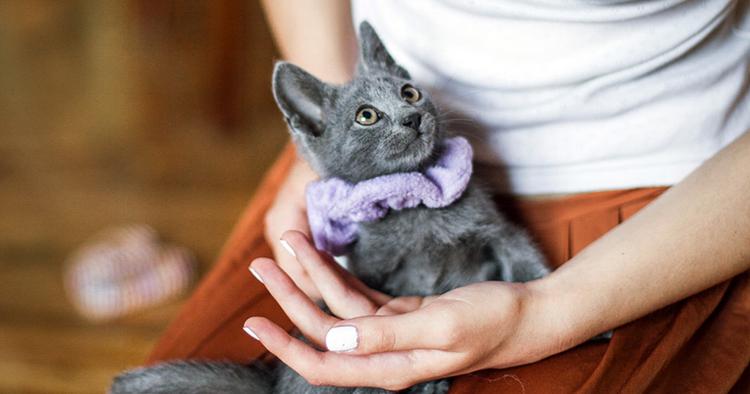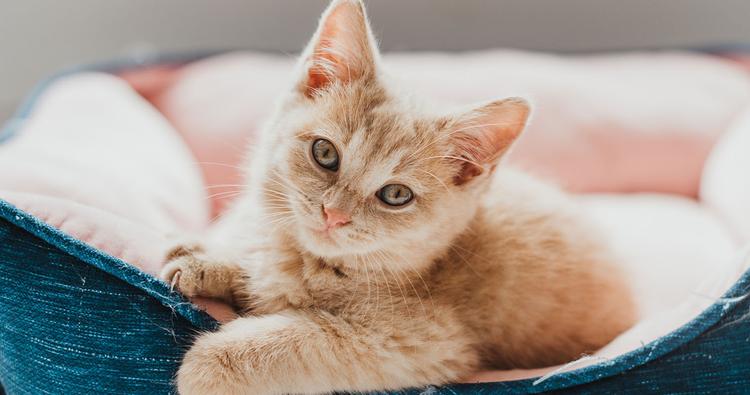How to Bathe a Kitten
Although kittens typically bathe themselves, there are occasions when a gentle bath is necessary.
Although kittens typically bathe themselves, there are occasions when a gentle bath is necessary.
by Katie Koschalk, | August 27, 2024

Ilike / Shutterstock
Kittens are notoriously messy eaters, especially as they transition from mother’s milk or formula to wet food. They may also walk in their food, have accidents as they learn to do their business on their own, and play in their litter boxes (what fun).
Kittens are naturally good at keeping themselves clean, but Gwendolyn Mathers, executive director at Tail Town Cats, says young or orphaned kittens may sometimes need a bath. “They may not be big or strong enough to groom themselves, or may have come from such dirty environments that they need a little extra help.”
Whether you adopted a kitten or are fostering one, knowing how to bathe a kitten properly can make the experience less stressful for both of you. Read on to learn the steps to give a kitten a safe and gentle scrub down.
Before we get into the how-to, let’s start by addressing some common questions about bathing kittens.
Kittens can’t regulate their body temperature until they’re about five or six weeks old, so bathing them when they’re too young could make them cold and increase the risk of hypothermia. For this reason, Mathers recommends waiting until a kitten is at least eight weeks old before giving them their first bath.
“You can bathe kittens younger than that, but it must be done safely and quickly,” Mathers says. But regardless of age, the kitten should be stable and warm, with no open wounds. She stresses that bathing a kitten in poor health is dangerous and can lead to hypothermia.
Mathers suggests using unscented dish soap or baby castile soap with zero fragrances or essential oils. Never use dog or flea shampoos, as they may contain chemicals that are toxic to cats. She adds that even pet shampoos specifically formulated for cats may be too fragranced or harsh for kittens’ delicate skin.
Typically, kittens do not need frequent baths. Only bathe a kitten when absolutely necessary. Here are some situations that might necessitate a bath:
The kitten gets something sticky, dirty, or potentially harmful on a large portion of their fur
The kitten has diarrhea that gets on a large portion of their fur
The kitten has a flea infestation
Flea infestations are common in newly rescued cats and can be extremely dangerous for kittens. Mathers explains that kittens younger than five to six weeks are too small for conventional flea medications, and the blood loss caused by fleas can lead to fatal anemia. As such, giving a kitten a flea bath is sometimes necessary to protect their health.
Before you bathe a kitten, it’s important to be well-prepared and understand the steps involved. Below is the step-by-step process for bathing a kitten.
First, gather all the supplies you’ll need:
A sink, pot, or large bowl to wash the kitten in
A small cup for pouring water
Kitten-safe soap
Kitten-safe treats
A towel
A rubber mat (optional)
Fill a sink, pot, or large bowl with warm (not hot) water. Don’t fill the water too high — it should only reach the kitten’s knees. To create a less slippery surface, you can put a towel or rubber mat on the bottom of the bathing container.
Running water can be frightening for kittens, so Mathers suggests using a cup to gently pour water over them to wet and rinse. “You can also lower their lower body into the warm water, but never fully submerge a kitten,” Mathers says.
She also stresses the importance of keeping the kitten upright and avoid putting their eyes, mouth, nose, and ears in water — as they can easily inhale water and become sick if it gets into their sinuses. To wash their face, use a warm, damp cloth and gently wipe.
If bathing to remove fleas, Mathers suggests making a ring of soap around the kitten’s neck to prevent the fleas from running up to their face (where you can’t wash them off). Then, lather a small amount of soap (about the size of a dime) over the kitten’s body and use a tight-toothed flea comb to trap and remove fleas or dirt. If bathing to remove dirt or other substances besides fleas, simply lather a small amount of soap over the kitten’s wet fur.
Rinse the kitten several times by using a cup to pour water over their body. Continue until all of the soap is removed. It’s very important to rinse off all of the soap because leftover soap can irritate the kitten’s skin. Mathers suggests that during rinsing, you try to remove any remaining fleas by hand or with a comb while the fleas are stunned and immobilized by the soap.
“Once the kitten is thoroughly rinsed and clean, quickly towel dry them as much as possible by hand,” Mathers says. If necessary, you can use a blow dryer on the lowest setting from several feet away, but do not use it close to their body, as it may scare them and burn their skin.
After towel drying, immediately move the kitten to a heat source and replace towels to ensure they don’t sit on anything damp, Mathers says. This is important to prevent hypothermia. You can then reward the kitten with a kitten-safe treat to create a positive association with the bathing experience.
When bathing your kitten, there are certain safety precautions you can take to keep both you and the kitten safe and comfortable throughout the process. Let’s review those, below.
The best way to avoid getting clawed while bathing your kitten is to keep the kitten's claws trimmed. You can also use a non-slip mat in the bathing container to help the kitten feel more secure and reduce the likelihood of sudden movements.
Anxious kittens may need extra reassurance during bath time. Speak to them in a calm, soothing voice and make gentle, slow movements. You can also try gently holding them by the scruff of the neck, which can have a calming effect similar to how their mother would carry them. Keep the bathing area quiet and free from commotion to further minimize their anxiety.
It’s important to monitor the kitten for signs of stress, such as excessive meowing, panting, or attempting to escape. If the kitten shows these signs, take a break and allow them to calm down before continuing. If the stress continues, stop the bath and try another day. You can also ask your vet or a cat behaviorist for advice on how to safely proceed.
If only a small area on the kitten needs cleaning, you can simply wipe that spot with a damp cloth or gently pour warm water over it. A small amount of soap can be used on those specific spots as well. This approach eliminates the need for a full bath, but be sure to follow the same safety guidelines as you would for a full bath.
Yes, frequent bathing can strip a kitten’s skin and fur of natural oils, leading to dryness and irritation. Only bathe a kitten when necessary, using a gentle, kitten-safe soap to preserve these essential oils.
Certain breeds, like Sphynxes and other hairless cats, may require more frequent baths to remove oil buildup on their skin. Cats with long hair, such as Persians, might also need regular bathing if their fur comes into contact with something sticky or dirty.
Dawn dish soap is safe to use to bathe kittens as long as you use Dawn Free & Clear, which is unscented. Other scented versions of Dawn contain additives that could be harmful to kittens.

Katie Koschalk is a freelance writer based in Northern California. Fusing her love and knowledge of animals with her journalism degree and years of professional writing, Katie is dedicated to improving the lives of pets and their caretakers by sharing helpful and accurate information. When she’s not at her desk, you can find her exploring trails with her Aussie, Hunter, cooking plant-based meals, and talking to her two cats, Jax and Sadie, in really ridiculous voices.

Foster & Volunteer

Adoption Advice

Adoption Advice

Adoption Advice
In the process of adopting a new kitten? Learn more about how you should introduce your adopted firend to their new home.

Adoption Advice
Adopting a new kitten? We've created a checklist to help you get organized before bringing your new friend home.

Adoption Advice
Are you bringing home a new kitten? Find out the best way to introduce your new kitten to your crew.

Adoption Advice
Considering adopting a cat? This comprehensive guide covers all the practical advice that will help you make an informed decision.

Adoption Advice
Worms are common in cats, especially in kittens. Thankfully, freeing your feline from worms is not that difficult.

Behavior & Training
From diet to health concerns, here’s a guide to how to know for sure, what may be causing this issue in your cat, as well as some potential treatments for it.